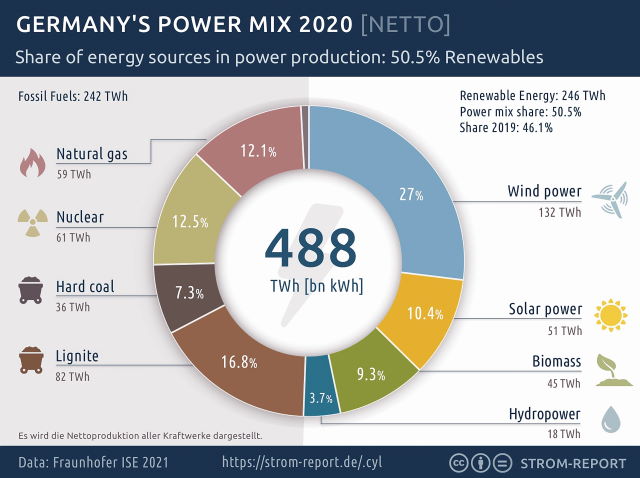Green Watch
Antidote for “Apocalyptic Environmentalists”: “Environmental Colonialism”
 After spending nearly $500 billion by 2019, only 42 percent of German electricity was generated by renewables, which, significantly, included carbon-emitting biomass as well as wind and solar. That same year Der Speigel had already declared that Germany’s “wind power boom is over.” Credit: Strom-Report.de. License: https://bit.ly/39gt29w
After spending nearly $500 billion by 2019, only 42 percent of German electricity was generated by renewables, which, significantly, included carbon-emitting biomass as well as wind and solar. That same year Der Speigel had already declared that Germany’s “wind power boom is over.” Credit: Strom-Report.de. License: https://bit.ly/39gt29w

Oliver Stone’s Antidote for “Apocalyptic Environmentalists” (full series)
Apocalypse Never | “Environmental Colonialism”
Nuking a Reasonable Compromise
“Environmental Colonialism”
This advice is nonsense, according to Shellenberger.
He fully covers the tedious renewable energy reliability trap. The wind doesn’t always blow, the sun doesn’t always shine, we’re laughably far away from the battery potential needed to store power for when we need it, and thus building out to any reasonable fraction dedicated to wind and solar swiftly escalates into a need for just as many traditional-fuel backup power plants as would have been needed without any wind or solar at all. (It is frustrating, yet necessary that Shellenberger and others must continue to repeat this obvious and easy-to-follow math. One day, maybe we should build a public education system so voters can learn these lessons as children?)
But Shellenberger’s bigger point is land use. According to one estimate he cites, “a wind farm requires 450 times more land than a natural gas power plant” to provide the same power capacity. And that is before an equally sobering discussion of the eagles, bats, owls, hawks, falcons, and other airborne predators that get pummeled by the massive spinning blades. Similar space and other habitat concerns afflict solar energy.
There are clear and unavoidable reasons why no rich nation is remotely close to switching over to wind and solar, and likely never will be. We all like to keep the lights on, watch our big screen televisions, and increase our wild spaces. It is “environmental colonialism” for any of us in rich nations to expect those in the Congo and other high-poverty nations to find a different path to our level of prosperity.
It’s not that the rich world hasn’t tried the renewable path. Apocalypse Never also explores the sad fate of Germany’s Energiewende “energy transition” to renewables.
After spending nearly $500 billion by 2019, only 42 percent of German electricity was generated by renewables, which, significantly, included carbon-emitting biomass as well as wind and solar. That same year Der Speigel had already declared that Germany’s “wind power boom is over.” Looking at the entire project, the behemoth consulting firm McKinsey recently concluded it was a triple threat to “climate protection, security of supply, and economic efficiency.” Shellenberger writes that German electricity prices in 2019 “were 45 percent higher than the European average.”
Energiewende is expected to cost an estimated $580 billion through 2025. Shellenberger writes this same investment in nuclear energy would have allowed Germany to generate “100 percent of its electricity from zero-emission sources and have sufficient zero-carbon electricity to power all of its cars and light trucks as well.” Making awful ironies worse, the Energiewende policy required a shift away from Germany’s nuclear plants.
Shellenberger doesn’t say so, but one might need to go back to World War II to find a more comprehensive public policy failure for Germany, which is saying a lot.
American efforts have failed less only because less has been attempted. Shellenberger writes, “Electricity prices in renewables-heavy California have risen six times faster than in the rest of the United States since 2011.” And California’s celebrated Ivanpah solar array “requires 450 times more land than its last operating nuclear plant, Diablo Canyon.”
In the next installment of “Oliver Stone’s Antidote for ‘Apocalyptic Environmentalists,’” examine Shellenberger’s pragmatic case for nuclear power.



